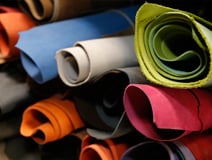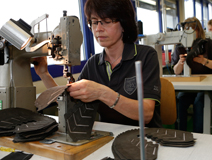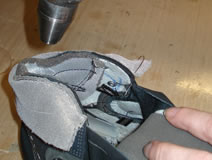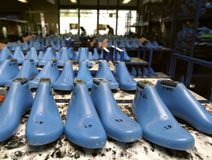Sign in
Contact
Lowa shoe manufacturing
The choice of leather
Leather is the main material used in the manufacture of footwear and is tanned to preserve it better. It is very strong, resistant to abrasion, stretchy, flexible, keeps its shape and, depending on its treatment, absorbs more or less water vapour. Moreover, it can be primed during tanning with a special hydrophobic impregnation that makes it waterproof.
For high-quality leathers, the tanning agents are firmly bonded to the fibres. Tanneries produce as much as possible in an environmentally friendly manner and all have their own treatment plants.
The Lowa brand only uses selected beef leather of European origin. It obviously contains no pollutants.
The different types of leather
The leather is chosen according to the use and the product:
- Smooth leather - upper layers of the skin, sensitive to scratches.
- Nubuck leather - upper layers of the skin (slightly scratched), relatively non-delicate and stable, ideal for trekking shoes.
- Suede - or split leather - middle layers of the skin, visible fibres, very robust, limited stretch and tear resistant.
- Hunting or Roughout Leather - very strong surface with a stable back, ideal for mountain boots.
Beef leather, is about six to eight millimetres thick in its raw state and must therefore be split. The specialists decide during the tanning process where the separation should take place: whether it should be a thick full grain leather and a thin split leather or vice versa.
Cutting
It's the same as in the manufacture of biscuits, hydraulic punching machines with cutting knives go through the leather. There is a cutting knife for each piece of a shoe, and also for each size. The quality of the finished shoe depends mainly on the placement of the cutting knife on the surface of the leather, which can vary greatly in structure and flexibility.
The stitching
After cutting, the leather parts must be assembled exactly with sturdy sewing machines. After stitching, seams including a GORE-TEX® lining will be sealed with a tape.
Glue and closure piece
Lowa has a special spray bonding process to ensure that the pores of the materials remain open so that water vapour is transported away from the foot. The metal eyelets and hooks are placed on special riveting machines.
The shape
The last is the piece of wood or plastic symbolizing the foot on which a shoe is made. The shoe (or more precisely the upper part of a shoe) is almost moulded to the last so that the specific characteristics of the use and the brand are transmitted into the inside of the shoe to achieve stability and a good fit.
There are special lasts for each type of shoe that are shaped according to particular requirements and empirical values. For women's models, Lowa naturally uses special lasts.
Assembly
In the shoemaking trade, the difficult process of forming and fixing the upper of the shoe (the upper without the sole) to the lasts is called "fitting". Heavy computer-assisted machines pull the upper over the lasts until it is properly positioned. The machine's clamps pull the lower edge of the upper as low as possible so that it can be fixed to the insole on the last with glue or small nails. The outsole is then attached to this insole which, depending on the desired flexibility of the shoe, can be soft or hard.
The rubber coating
A typical Lowa feature: the rubber coating is mounted separately. This rubber strip around the shoe protects the leather against damage and moisture.
Type of soles
Lowa uses almost exclusively rubbersoles which are usually fitted with a polyurethane foam (PU) midsole.
Both the underside of the mounted upper and the sole must be very well prepared before being glued together with pneumatic presses. Immediately after pressing, the adhesive is fixed in a cooling tunnel.
The shrinkage of the last
At the end of the production process, the last that served as a mould is mechanically removed from the finished shoe. Until recently, this difficult work was still done by hand. Nowadays, it is carried out by heavy machinery.
Finishing and quality control
During the final check, the shoe is given the final touch. The laces, insoles and composition labels are then applied and the shoes are boxed.





